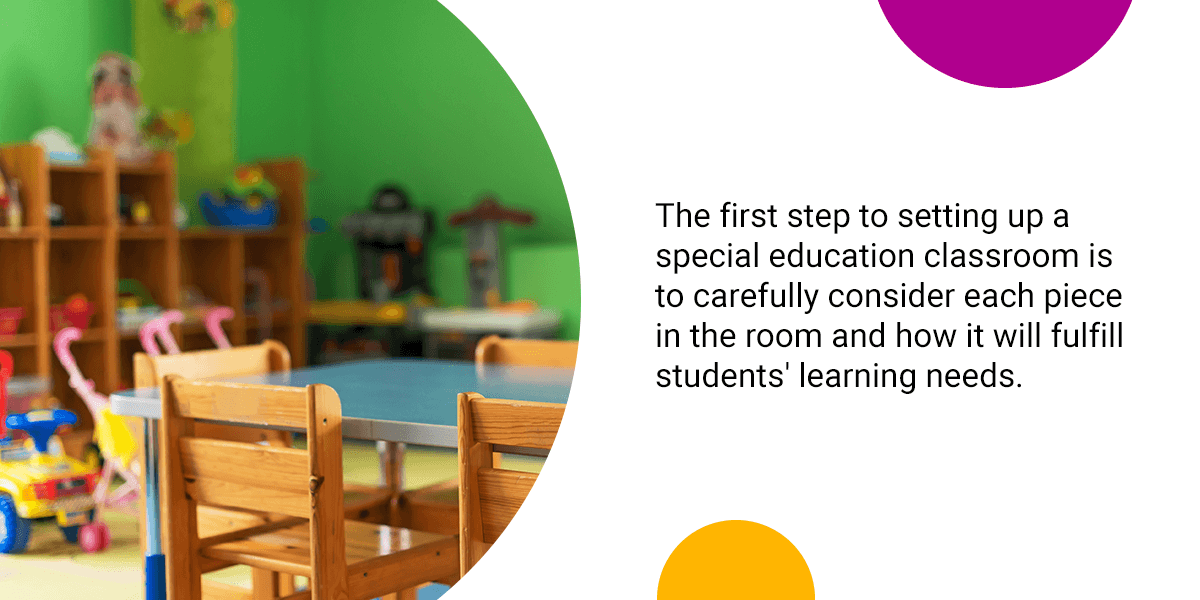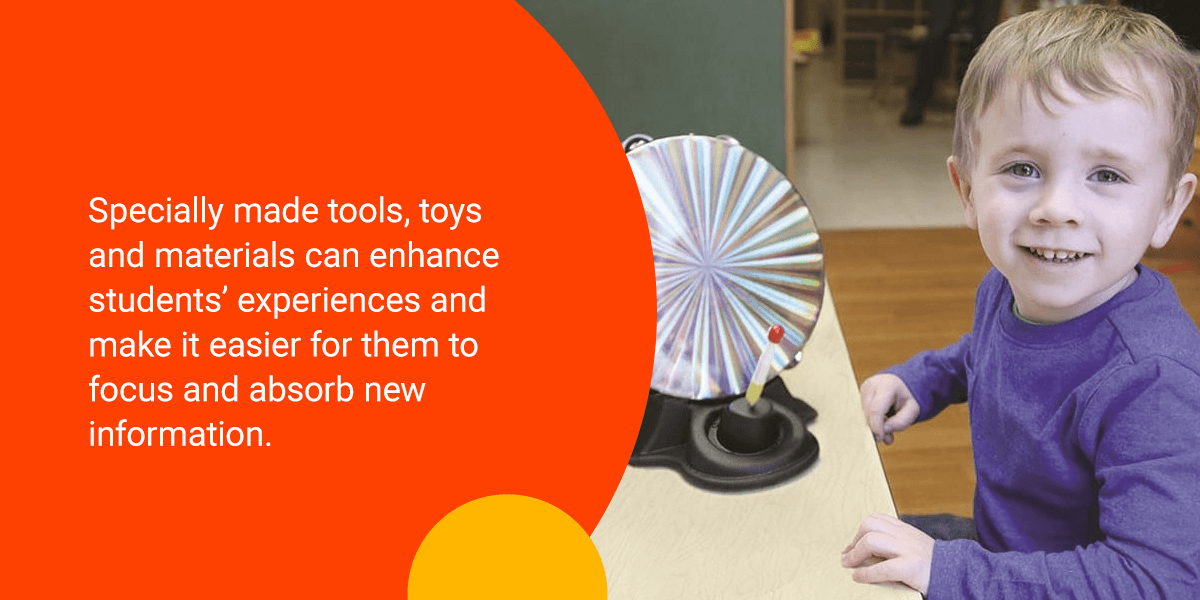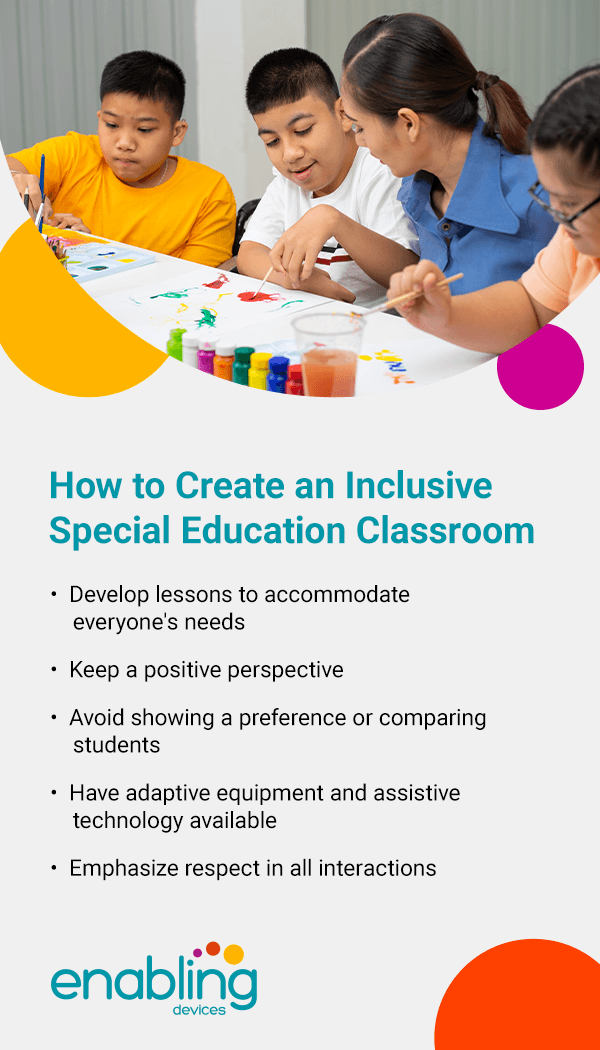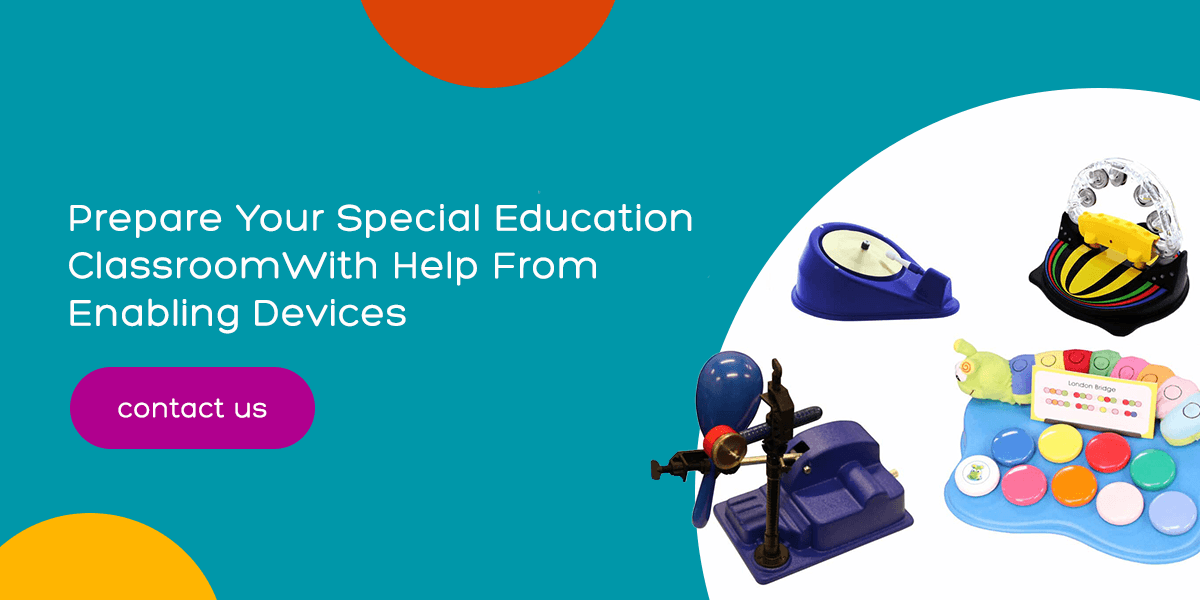A special education classroom should provide the support students need to successfully engage in learning activities, communicate more effectively and minimize behavioral problems.
With high-quality tools, devices, toys and electronics from Enabling Devices, you’ll have everything you need to support a wide range of functional levels. This guide provides tips for decorating your ideal special education classroom.
Special Education Classroom Setup and Decorating Ideas
The first step to setting up a special education classroom is to carefully consider each piece in the room and how it will fulfill students’ learning needs. Here are some special education classroom decorating ideas to keep in mind.

- Consider the age range: While many special education teachers have students of varying ages and abilities, you’ll want to find appropriate room decorations for the students in your classroom. If possible, wait until you find out the actual and developmental ages of your students before choosing materials and room décor. Some students may benefit from certain seating arrangements or educational devices.
- Determine the layout: Your special education classroom layout should include separate areas with specific uses, such as a play area or calming area. At the same time, be sure to leave space for children with mobility devices to navigate the room.
- Arrange the classroom to fit your teaching methods: Every teacher has a unique teaching style. Arrange your special education classroom according to your own teaching style. For example, if you prefer for students to work collaboratively, arrange desks closer together. If you prefer them to work individually, space out the desks accordingly.
- Create a fun, comfortable and calming environment: It is critical that your special education classroom is comfortable, accessible and pleasant for students. Consider decorating with bright, fun colors or delineate sections by choosing different color combinations for each section.
- Feel free to brainstorm: Get creative with the themes available. For instance, a camping theme might incorporate different elements of nature, whereas a city theme might include areas that resemble a public park or town hall. Check out our blog post on back-to-school theme ideas for special education teachers to get inspired.
Rules for a Special Education Classroom
Meaningful routines and structure offer consistency and predictability for all children. Knowing what to expect as they enter your classroom will help students to feel relaxed and create an environment that is well-suited for healthy interactions, improved social skills and behavior management.
When creating rules for your classroom, consider the ages, needs and abilities of all students. For example, don’t expect students with certain mobility challenges to raise their hands before speaking. Likewise, being asked to listen when others are speaking will not accommodate a student with a hearing impairment.
Here are examples of special education classroom rules to use as a starting place. When you arrive at a list of rules that appropriately accommodate all students, post them on the board to remind students to follow them.
- Raise your hand or signal the teacher when you have a question.
- Look and listen during instruction.
- Use kind and positive language.
- Stay seated during activities.
- Keep your hands and feet to yourself.
- Bring your homework to school.
- Always try your best.
- Follow directions.
- Use your quiet voice.
- Be respectful to others.
Special Education Tools, Equipment and Materials
Specially made tools, toys and materials can enhance students’ experiences and make it easier for them to focus and absorb new information. Certain equipment can also help them improve their daily living skills, both at home and at school.

The following are special education classroom items you may want to consider:
- Tactile Manipulatives: Squishy, textured toys help students feel more focused and less stressed while strengthening their hands and fingers and enhancing tactile processing.
- ADL Boards: Activities of Daily Living (ADL) boards are beneficial for students of all ages with functional needs, also referred to as special needs. These tools allow students to enhance fine motor skills that they need to dress, such as zipping, snapping and lacing, which can also help them learn to grasp writing tools or press buttons on communication devices.
- ATL Bundles: These adapted toys with switches can increase students’ visual and auditory attention and teach them about cause and effect.
- Finger Isolation Button: This device is designed with a recessed button to help students learn how to master finger isolation and other fine motor skills needed for using touchscreen devices and computers.
- Weighted Hand Writing Glove: A weighted glove is a must-have for any special education classroom because it offers proprioceptive input and compression that some students may need to perform various activities, like writing and drawing. This glove enhances maximum finger flexibility and wrist mobility and elevates strengthening exercises.
Elementary School Special Education Classroom Tips
Children in elementary school will generally be five to 10 years old. With that in mind, here are some elementary special education classroom tips to try:
- Use alternative aids: For students with visual or hearing impairment, consider using visual or auditory aids that allow them to engage and respond in lessons and activities. Devices for these impairments allow elementary school students to be more interactive when learning.
- Create a predictable schedule: Children with varying needs and abilities can benefit from a predictable routine in the classroom. When you anticipate a change in their routine, such as a field trip, special guest or substitute teacher, it’s best to let your students know in advance so they feel comfortable and prepared when the day comes.
- Provide plenty of opportunities for breaks: Children with special needs develop their skills on different timelines, so it’s important to offer a safe calming area for them in the classroom, such as a sensory space. A sensory space allows them to engage with tools and toys that provide a relaxation break before returning to learning.
- Consider environmental triggers: Look around your classroom and determine if there are any bright lights, extreme temperatures or loud noises. These factors can disrupt a child’s thought process and behavior, potentially leading to an outburst. Decorate your classroom with warm lighting and use soothing music to help keep everyone calm.
- Use discipline gently but effectively: Elementary-age children of all needs and abilities may struggle to stick to certain rules and behaviors. Determine an effective strategy for promoting and supporting good behavior with simple and straightforward language. Be sure to help your students learn what is expected of them and build trust and respect, but be gentle with your tone, volume and body language.
- Make learning easier with tools, toys and devices: You can entice younger children to learn and communicate more effectively with devices that assist them in their daily activities. For example, toys that calm anxiety can help with focus, and communicators make it easier for students to express their needs. These sensory and functional products are great additions for engaging the five senses and promoting relaxation.
Middle and High School Special Education Classroom Tips
Middle and high school special education students may be aware of their different needs and abilities when around their peers, so it’s critical to ensure your classroom is a place for them to feel supported, empowered and engaged in learning. Here are some ways to make older students feel at ease:
- Use a mix of learning materials and tools: Your students will have a variety of proficiency levels and abilities in the classroom, so having a mix of books and resources can provide students with manageable assignments and activities. You can also modify or adjust assignments to minimize frustration and maximize confidence.
- Discuss disabilities openly and reduce stigma: Some middle and high school students with special needs may feel ashamed of their symptoms and functional differences. As a special education teacher, it’s important to help students understand disability. Talking openly about students’ needs and abilities can help them capitalize on their strengths and feel motivated to learn more about themselves.
- Use assistive tools and technologies: There are plenty of assistive technologies and products to aid students in learning, such as special education classroom kits for students who have sensory processing disorder, speech or visual impairment, autism or cerebral palsy.
- Create a responsive classroom environment: Learn how each of your students can and prefers to communicate. Whether a student is verbal or uses augmentative and alternative communication (AAC) devices, speaking their language can help them build trust with you and feel more confident in participating.

How to Create an Inclusive Special Education Classroom
Teachers and educators play a valuable role in promoting inclusivity in special education classrooms and throughout the entire school. Here are some ways you can support inclusivity among students:
- Develop lessons to accommodate everyone’s needs: It’s important for teachers to educate themselves on each student’s needs, limitations and boundaries to better understand how to build inclusive lessons and make alterations to assignments. You may also modify seating arrangements or develop creative ways to meet your students where they are.
- Keep a positive perspective: Modeling a positive attitude while teaching special education in the classroom is an effective way to help your students feel more confident in themselves and their ability to succeed in school. Keep in mind that some students may not always meet learning outcomes as expected. Focus on the big picture, such as the fact that they are engaging in your classroom and learning something new.
- Avoid showing a preference or comparing students: In any educational setting, showing preference or favoritism toward certain students can make others feel that they are not doing enough, which can create a divisive classroom. A special education inclusive classroom starts with eliminating exclusion, comparison and stereotypes, which allows children to grow and learn regardless of their abilities.
- Have adaptive equipment and assistive technology available: Your students may have varying needs and abilities when it comes to speech, vision, hearing or mobility. Providing appropriate adaptive and assistive devices helps promote inclusion and allows all students to engage in activities. Some of these devices might include adaptive switches, capability switches, communicators and boards.
- Emphasize respect in all interactions: Part of maintaining an inclusive and positive environment is reminding students to humanize their peers who might have different abilities from them. Encourage students to introduce themselves and remind children to be respectful of others’ feelings, even if they don’t know at first how to speak to or include an individual with disabilities.
Teaching children how to include peers with disabilities can be challenging for some parents and teachers. Find out more about how to help kids learn to include and understand classmates with different needs.
Teaching Strategies for a Special Education Classroom
Your teaching methods may vary depending on the age group and special needs of your students. Explore these general teaching strategies you can practice in your special education classroom:
- Group students according to their abilities: Form small groups of students according to their needs, abilities and skill levels. This structure can help your students avoid comparing themselves to others and instead focus on their group and their assigned activity.
- Create specialized areas around the classroom: Designate certain areas of the classroom for specific activities and instruction. Ensure that each space specializes in one level or subject for your students to focus on at a time and include various learning materials for them to engage with.
- Review the previous lesson: Once you’ve covered a new subject or lesson in class, review it before jumping into the next one to determine if every student is ready to move on. Emphasize key points of the lesson and check in with your students to ensure they understand.
- Provide follow-up directions: After instruction, it’s always best to repeat yourself or provide additional directions so your students are confident in what they need to do. Remind students to ask for help if they do not understand your directions.
Teaching Strategies for Students With ADHD
Students with attention-deficit/hyperactivity disorder (ADHD) may present an impaired ability to listen, focus or finish a task. This disorder may sometimes cause students to fidget or display disruptive behaviors in class. Here are some special education classroom ideas for teaching students with ADHD:
- Personalize their learning: Students do not learn in the same way. Some may show strengths in different areas than others, such as the ability to sit still or stay organized. Consider hands-on, interactive activities with manipulatives to help keep students with ADHD focused and engaged.
- Offer choices: Some assignments with many steps can be overwhelming for students with ADHD, so try offering several ways for them to finish an assignment. When learning math, for example, allow them the choice of using a calculator, writing problems on the board or working quietly on a worksheet to complete their assignment.
- Accommodate their attention span: Students with ADHD will perform tasks more effectively without distractions. Give them a quiet area to work, allow them extra time to finish or split up the assignment in separate stages rather than all at once.
- Reward students for good behavior: Many children with ADHD may become accustomed to constant correction or scolding for their behavior. You can make a huge difference in their learning by focusing on their positive behaviors. Offering praise for even minor accomplishments can motivate them to continue these behaviors.
Prepare Your Special Education Classroom With Help From Enabling Devices
As a special education teacher, you know how important it is to ensure every child has access to learning regardless of their needs and abilities. To create an inclusive and accessible classroom, start by introducing adaptive devices and assistive technology from Enabling Devices. We’re proud to create exceptional products to help individuals with disabilities achieve their goals, from communication to learning to play.
We understand that each student is unique, and it’s our goal to create products that align with those needs. We’re passionate about enabling possibility and unlocking potential in all students. Contact us today to learn more about how our devices can help enhance learning for your students.



